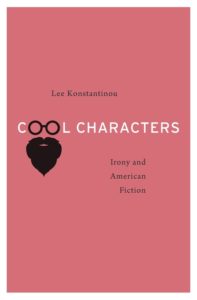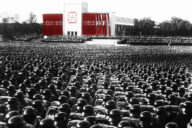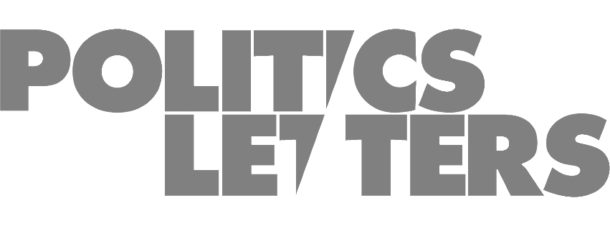By BEN PARKER
 Review of Lee Konstantinou’s Cool Characters: Irony and American Fiction (Harvard University Press, 2016).
Review of Lee Konstantinou’s Cool Characters: Irony and American Fiction (Harvard University Press, 2016).
In his essay “Inauguration Day, January 2001,” Jonathan Franzen recounts attending a political protest against the Supreme Court’s decision in Bush v. Gore. But I am not being entirely accurate. Since the essay is written in the second person, it is not Franzen who (abjectly) took a bus trip from New York to (ineffectively) participate in (incoherent) mass political action, but rather you. To this first level of remove has to be added a second remove of internal distance, since you—Franzen, remember—bring equal parts skepticism and nostalgia to the slightly pathetic spectacle of left activism; the whole piece is narrated in conditional subjunctive. And then a third remove is introduced when the protesters march by the self-satisfied bourgeois who are not protesting but having a nice evening out—when “you might have had the deeply weird experience of seeing yourself seeing yourself,” (How to Be Alone, 305-6) since you more commonly would be over there with them, clinking wine glasses, and not in the rain with the activists. When you get home, drenched and cranky, you remove your “long day’s costume, and you see a wholly different kind of costume hanging in your closet” (306): the trappings of literary and professional respectability, of compromise. The entire drama of the essay, we now see, is the burning divide, in your Franzen soul, of how can I attend a political protest and also own expensive shoes, while remaining one person?
Although Cool Characters, Lee Konstantinou’s book on irony and American fiction from 1945 to the present, only mentions Franzen in passing, “Inauguration Day” neatly condenses the dynamic of political irony that Konstantinou analyzes at greater length. On one hand, both authors track a nostalgia for (or envy of) authenticity defined as a non-contaminated, spontaneous disposition; but on the other hand, they register a suspicion of countercultural or activist self-definition, a desire to catch it out as naïve or facile. The Franzen type of self-examining distance, trapped in this particular cultural vice, exemplifies the disheartened anxiety that anything not entirely authentic and emerging from my total personality somehow does not “count,” or is possible only in bad faith—and is thereby incapacitated for meaningful political engagement.
Konstantinou’s book purposes both to historicize and to cure this agitated quietude, to provide “a historical sense of the changing political fortunes of countercultural irony, a sense of why irony took on and lost political significance in the twentieth and now the twenty-first centuries” (288). In his timeline, “Inauguration Day,” narrating events prior to September 11, 2001, would belong to a now-superseded regime of postmodern irony, in which the incisive and demystifying critique of the sophisticated intellectual could become incapacitated by turning upon itself. The period since then, however, has seen the rise to dominance of “postirony,” a turn away from critical subversion and self-undercutting nihilism towards re-enchantment, sincerity, quirkiness, and affirmation. It may even be that “postirony” names the entire cultural field of what comes after “textbook postmodernism” (4). This periodization of irony and postirony is, I think, uncontroversial. The late David Foster Wallace, who looms hugely over Cool Characters, had already announced the end of “(r)idicule, nihilism, sarcasm, cool, and irony,” and the same delineation has been echoed in the rebranding of academic criticism as postcritical—engaged in distant or surface reading rather than paranoid, suspicious, or symptomatic critique. In a sense, then, postcritical academic critics like Franco Moretti and Rita Felski belong with Dave Eggers and the figure of the Manic Pixie Dream Girl, as part of a larger “backlash against postmodern irony” (8).
With this periodization in place, the contention of Cool Characters is roughly that the postironists have “misread the political history of irony” (xii). Postironists tell a story of how the initial critical force of irony was subsequently co-opted, incorporated, or simply exhausted by its very ubiquity—notably in analyses of “cynical reason” by Peter Sloterdijk and Slavoj Zizek, or Thomas Frank on the commodification of counterculture. Konstantinou just extends this indictment to postirony itself, a version of tu quoque. So, postirony could no more escape the ruse of neoliberal reason than could irony. The postironic strategy of “mov(ing) beyond irony might inadvertently serve the political economic order that (it) sought, in other ways, to resist” (xii). Both irony and postirony, then, can become “troublingly imbricated” in the workings of the status quo (xii).
This is not to say that Konstantinou comes down harshly on either enterprise. Rather, his tone is diagnostic throughout, aiming to “be evaluative—to assess” the aspirations, fluctuations, and self-definitions of both irony and postirony, to “not only take seriously the aspirations” of these endeavors, “but also expose the intellectual and aesthetic errors” they are rooted in (9). This evaluative posture is abetted by his critical methodology, which must either fly over or hack through an enormous body of commentary. For not only is irony notoriously difficult to define, but the attempts to do so go back as far as Socrates and Aristotle, and continue up through Kenneth Burke, Wayne Booth, and Richard Rorty. In the book’s introduction, Konstantinou gives a tour of the many terms associated or nearly synonymous with irony: skepticism, cynicism, critique, postmodernism, Bohemianism, epistemological anti-foundationalism, satire, perspectivism, kitsch, polysemy, symbolic revolt, snark, or literary theory itself. The set of irony’s opponents is just as extensive: authenticity, sincerity, passion, commitment, decision. (I would have added: false consciousness.)
Konstantinou attempts to outflank this tangle of competing definitions by categorizing them into four different models of irony: the cognitive, irony’s “status as a speech act” (10); the antifoundational, irony as ceaseless interrogating and exhausting interruption; the historicist, irony as a felt loss of faith in modernity; and the characterological, which sees irony in terms of “character, attitude, sensibility, disposition, and ethos” (15). Just as Fredric Jameson claimed the collective or anagogical interpretation to subsume and recapitulate the other levels of medieval allegory, so Konstantinou sees this final model, character, as the master code behind the others. This would all have been clearer if Konstantinou, instead of giving a scenic tour of the critical literature, had “run” each model on the same object, for instance Dostoevsky’s Notes from the Underground. Irony’s cognitive aspect, then, would be the self-undermining loopholes permeating the Underground Man’s discourse; the antifoundational aspect would be his gadfly-like dismantling of utilitarian reason; the historicist aspect would be Dostoevsky’s framing of this character in terms of Western atheistic rationality; and the characterological aspect would be his irritating habits, corrosive postures, and nihilistic commitments—his personality, or what Georg Lukács analyzed as the “intellectual physiognomy” of character.
Organizationally, then, Cool Characters is loosely structured after Hegel’s Phenomenology of Spirit, provided one sees the latter book as a progression of character analyses—what is the particular mode of failure immanent to that famous series of personalities: Master and Slave, the Unhappy Consciousness, the Frenzy of Self-Conceit, the Beautiful Soul? Konstantinou’s characters (he leans on the sense of character as ethos, and is less interested in, say, fictional persons like Antigone or Huck Finn) are The Hipster, The Punk, The Believer, and the Coolhunter. Konstantinou’s procedure is about the same in each case study: to reveal how the allegedly subversive or critical posture is unhappily complicit in or contained by the political forces it would itself undermine and redefine. Thus, the midcentury irony of Norman Mailer’s Hipster, as located in Ralph Ellison’s Invisible Man and Thomas Pynchon’s V., did not have “an unambiguously critical mission,” as is supposed by those who would trace its later fall into blunted obsolescence, but was always already “troublingly imbricated with Cold War liberalism.” (xii) Likewise, the antisocial dystopianism of Punk turns out to have “helped shape the world of early neoliberalism” (107), via a dialectical inversion where the Do It Yourself ethos of punk unexpectedly presages the austerity-era creative class of “temporary project-oriented groups linked together into voluntary networks” (115). The transition to postirony has its avatar in the Believer, an ethos of “nonnaïve noncynicism” (174) exemplified not so much by any character but by the figure of David Foster Wallace himself, or himself as produced by the techniques of metafiction, which “exhaust the reader’s reflexive irony, to take the reader to the limit of critical thought in order to prepare the way for her willingness to believe in the sincerity in the author.” (193) (I found this sense of “belief” to be cheating a bit on Konstantinou’s part. The question here is whether the troubling of fictionality in Wallace and Dave Eggers can stir some heat out of the ashes of readerly distance. But this is not belief in something, it is only belief that something “really” happened or not, or that the author is in earnest). In any case, this attempt “to create worldly reenchantment through an aesthetic practice” (41) dead-ends in the “user-friendly avant-garde” of McSweeney’s, now “fundamentally integrated into the heart of hip urban areas zoned for retail” and (therefore?) “clearly incapable of overcoming the depredations of the End of History.” (216) In the last chapter, the Coolhunter—the sort of trend forecaster exemplified in real life by the group K-Hole and their prediction of the anti-style of “normcore”—fares no better than her predecessors. In Jennifer Egan’s A Visit from the Goon Squad, the Coolhunter is “subsumed by the total commodification of everyday life,” and the novelist is “ultimately unable to entirely reject” the reifying logic of branding (268). The conclusion tentatively invests hope in a new figure, the Occupier, although this character is similarly hedged about with affective limitations, whether it be the fuzziness of her objectives or a tendency to merely virtual solidarity.
This historical procession inevitably leaves out some crucial exhibits while cramming others into the desired place. The genealogy of postironic sincerity surely ought to include J.D. Salinger, whose absence here ensures a much neater timeline. In the chapter on punk, almost the only (actual) punk band mentioned is The Sex Pistols, whom Konstantinou reads with dismaying inaccuracy in terms of the DIY ethos. This is even more puzzling since he is simultaneously aware that the band was assembled, Monkees-like, by the Svengali figure Malcolm McLaren. Unfortunately, this cognitive dissonance could not have been resolved by just choosing a better example of DIY (say, Crass, or in the relevant American context, The Misfits), since the “gotcha” aspect of Konstantinou’s argument precisely depends on the Sex Pistols as an instance of “punk marketing” (110). The discovery, in the context of Dave Eggers’s novel A Heartbreaking Work of Staggering Genius, that the very fact of an audience provokes a fraught, “self-devouring… proliferation of discourse… which must acknowledge (its) own potential corruption,” (198) is only to transfer the vexed aspirations of Robert Browning’s monologists onto the starved terrain of the contemporary memoirist’s fussy logorrhea. And a final distinction, between the 1950s Hipster and the contemporary hipster, misses the opportunity to translate the racial anxieties of the former into the latter’s citation of working class white identity (Pabst Blue Ribbon beer, trucker hats, tattoos, the lumber industry).
These minor quibbles notwithstanding, the characterological approach to irony has much to recommend it. We are no longer dealing with a constantly-retreating rhetorical device or abstract epistemological antifoundationalism—modes where irony is strangely secure, like a guerilla army which can disappear back into the populace or into a network of underground burrows. Instead, human personality allows for fixed experimental conditions. For instance, whatever the appeal of the postironic enterprise as a cultural statement or “turn,” it is much less attractive when we see it rhetorically staged by Dave Eggers. The gamble for the reader’s non-cynical “belief” simply fails; Eggers is too unlikeable or simply irritating. We reject this personified ethos as a person. Furthermore, Konstantinou awards no “political” points simply for one’s taking up this personality or disposition as opposed to that—an admonition that cannot be made strongly enough in our moment. It is likewise refreshing to see him argue, as a corollary to this point, for the deflation of “symbolic” politics. While “there is no simple way to blithely differentiate between the real and the symbolic,” there is a good deal of question-begging and confused substitutions in the academy’s “alternative political technology of culture” (35). There is great wisdom in the reflection that, “If we could easily disentangle (real from symbolic politics), we would already have… accomplished the political tasks we deem important.” (36)
The political upshot of this survey of irony’s characterology across seven decades is that “irony did not, even in its most avowedly countercultural forms, necessarily aid projects of human liberation. Nor… will we be able to predict in advance the future political significance of postirony” (288). What then does Konstantinou prescribe in the place of irony and postirony? Admitting that his own agenda is “unabashedly normative” (9), he recommends (but does not specify) “specific ambitious, sustainable, scalable, and—yes—sometimes dull political projects” (287). The implicit evaluation of irony and postirony which we are left with is that, as dispositions, they lack the somber maturity and—yes—dullness required of liberal political ambitions. Snark and quirk are, after all, poor fits for consensus-building and unsexy organizational work. In the same vein of stringent Bildung, the concluding readings of two novels from 2013, by Rachel Kushner and Jonathan Lethem, gesture towards how irony and postirony might be transcended by what we are clearly meant to read as “actual” rather than symbolic politics, namely the Italian Workerist movements of the 1970s (in Kushner’s The Flamethrowers) and a Communist-inflected interpretation of Occupy! (in Lethem’s Dissident Gardens).
In the end, Konstantinou concedes, “(w)hat may matter most… is not whether we live lives of irony but rather where we target our irony and how our ironic attitudes inform a larger sense of political mission.”(xiii) But this is jarring; surely the point of the lengthy characterological analysis was that “ethos, irony, disposition, orientation, stance” were worthy objects of immanent critique—that the limitations and projections of these figures were built-in as ways of political being, not detachable or optional attitudes. I read the argument as saying that it was some definite feature or trend of irony and/or postirony which led their critique to be swallowed or inverted by neoliberalism. In other words, the book’s dialectical “motor” was the internal pivots and nuances of irony’s political responsiveness. But if neoliberalism is taken instead to be the “motor” of the account, characterology begins to look like the scanning of passive and merely reactive attitudes towards this behemoth. The irony/postirony distinction is then simply rearranging the deck chairs on a sinking ship, in the face of the external historical fact of neoliberalism. The errors and misprisions of irony are, on this reading, imposed from without; the “cool characters” are simply various accents of a moribund criticality, rather than Hegelian bearers-of-Spirit.
But does it then follow that “(w)hat may matter most… is not whether we live lives of irony”? Even granting the primacy of discrete political objectives, it ought to matter very much whether we live ironically or not. For the cultivation or recommendation of irony as an ethos, as Amanda Anderson has argued, does not follow necessarily from any antifoundational epistemological claims, but can only be evaluated in terms of what conception of agency and communication gets us from point A of our lived contingency to point B of our achieved goals. If irony as an intentional stance or self-conscious bearing is seen as either undercutting the solidarity and earnest commitments required for political work (as in Franzen’s crippling self-awareness), or as tending to become non-political or merely an aesthetic/symbolic end in itself, then why let it off the hook? In any case, Konstantinou himself plainly endorses a non-ironic ethos of focused commitment (288). What radical activism lacks, it would seem, is stick-to-it-iveness—we need to “apply ourselves,” as the teacher-student lecture so often goes. The 99% that he imagines is not only the indebted and disenfranchised, but also the perspiration of Edison’s epigram. The problem turns out not to be ethos as such, but rather the extensive drawbacks of irony and postirony. The expiration date of the former has already passed, but there is still hope that postirony could take another form (the sober, pragmatic rigor of non-irony) than the unappealing forms on display here (contentless “belief,” the slimy reach of trendspotting).
The political demotion of irony ultimately leaves us still within the characterological, but now in a sense closer to the rhetorical, since the emphasis finally lands on persuasion, motivation, and “prefiguration” (287). In the best sense, then, Konstantinou recalls and restores sense to some remarks of Mikhail Bakhtin’s in a strange work, “Author and Hero in Aesthetic Activity”—that the questions that make up “the motivational context of an act” are questions like, “what for? to what end? how?,” but never “who am I? what am I?” (139). The “who”—whether in a characterological sense, or in the construction and collective recomposition of new Subjects—is now on the agenda.
***
Ben Parker works on the nineteenth century British novel, especially on the relation between narrative and ideological closure. He is writing a book called The Awful Victorian Plot about Victorian recognition scenes and reification. He has also written about Fredric Jameson, Karl Ove Knausgaard, western movies, Game of Thrones, New York hardcore punk, the Katy Perry movie, and Georg Lukács. In the fall he will be Assistant Professor of English at Brown University.






No Comments